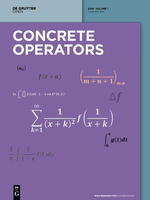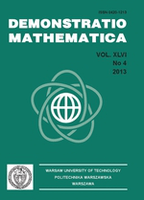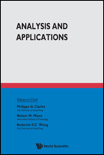
Concrete Operators
metrics 2024
Innovating Analysis: Where Theory Meets Application
Introduction
Concrete Operators is an innovative academic journal published by DE GRUYTER POLAND SP Z O O, specializing in the fields of Analysis and Applied Mathematics. With an ISSN of 2299-3282, this open access journal has been dedicated to fostering scholarly communication since its inception in 2013. Concrete Operators aims to provide a platform for researchers, professionals, and students to explore and disseminate significant findings in mathematical analysis and its practical applications. Housed in Germany, with administrative offices located in Warsaw, Poland, the journal embraces a global audience. Notably, as of 2023, it holds a Q4 category ranking in the respective mathematical domains, reflecting its commitment to emerging research within the community. The journal's open access model enhances visibility and accessibility, encouraging collaboration and innovation among mathematicians. By bridging theoretical advances with practical implementations, Concrete Operators plays a vital role in the advancement of mathematical sciences.
Metrics 2024
 0.24
0.24 0.30
0.30 0.70
0.70 7
7Metrics History
Rank 2024
Scopus
IF (Web Of Science)
JCI (Web Of Science)
Quartile History
Similar Journals

Banach Journal of Mathematical Analysis
Connecting Scholars through Innovative Mathematical ResearchWelcome to the Banach Journal of Mathematical Analysis, a distinguished publication under the auspices of SPRINGER BASEL AG, dedicated to the field of mathematical analysis and its applications. With a strong reputation reflected in its Q2 ranking within both Algebra and Number Theory as well as Analysis categories for 2023, this journal serves as a pivotal resource for researchers and professionals striving to advance their understanding and contributions to the mathematical sciences. As an esteemed platform featuring innovative research from around the globe, the journal promotes open discourse among practitioners of various mathematical disciplines. Although currently not an open access journal, it enhances visibility through rich content, consistently ranked with notable Scopus metrics, including impressive standings in both algebraic structures and analytic methods. Join a vibrant community of scholars who are shaping the future of mathematics by exploring the latest insights and methodologies published within these pages.

HOUSTON JOURNAL OF MATHEMATICS
Cultivating Academic Dialogue in Mathematical ResearchHOUSTON JOURNAL OF MATHEMATICS, published by the University of Houston, serves as a valuable platform for disseminating significant findings in the field of mathematics, specifically within the realm of miscellaneous mathematics. Despite its current categorization in Q4 for 2023, the journal plays a crucial role in fostering academic discussion and exploration among researchers, professionals, and students alike. With its ISSN 0362-1588, the journal has been publishing original research since 1996, with a recent gap filled from 2022 to 2023, thereby continuing to contribute to the mathematical community. While it does not currently offer open access options, the journal's commitment to quality research maintains its relevance within the field and invites submissions that can elevate its standing. Located in the vibrant city of Houston, Texas, the journal not only emphasizes theoretical advancements but also encourages applied mathematical research that intersects with other disciplines, enhancing its significance and reach.

Advances in Operator Theory
Illuminating Complexities in Operator TheoryAdvances in Operator Theory is a premier journal dedicated to the exploration of innovative and foundational research within the disciplines of Algebra and Number Theory, as well as Analysis. Published by SPRINGER BASEL AG, this journal provides a vital platform for the dissemination of high-quality research and theoretical advancements in the realm of operator theory. With a commendable impact factor and categorized in the Q3 quartile for both Algebra and Number Theory and Analysis in 2023, it holds significant standing in the Scopus rankings, substantiating its relevance in the mathematical community. The journal encourages open discussions and lively exchange of ideas among researchers, professionals, and students alike, fostering an environment conducive to scholarly growth and collaboration. Based in Iran at PICASSOPLATZ 4, BASEL 4052, SWITZERLAND, it has been actively publishing since 2016, making substantial contributions to its field through rigorous peer-reviewed articles. As an essential resource for anyone invested in the forefront of mathematical research, Advances in Operator Theory continues to illuminate complex topics and inspire future inquiries.

Demonstratio Mathematica
Nurturing a Global Community of MathematiciansDemonstratio Mathematica, published by DE GRUYTER POLAND SP Z O O, is an esteemed open-access journal in the field of mathematics, with an ISSN of 0420-1213 and E-ISSN 2391-4661. Established in 1996 and providing open access since 2009, it has become a vital platform for disseminating innovative research and advancements in various areas of mathematics. With a commendable Scopus ranking of 85/399 in General Mathematics and a 2023 Category Quartile of Q2, it stands at the forefront of the mathematical community, demonstrating a significant impact within the top 78th percentile. The journal aims to foster a deeper understanding and appreciation of mathematical concepts and their applications, catering to both seasoned researchers and emerging scholars. Located in Warsaw, Poland, Demonstratio Mathematica not only enriches the academic discourse but also strengthens collaborative efforts within the international mathematics community, making it an essential resource for those seeking to expand their knowledge and research output.

Annales Fennici Mathematici
Fostering Insightful Discoveries in MathematicsAnnales Fennici Mathematici is a prestigious academic journal published by Suomalainen Tiedeakatemia based in Helsinki, Finland. With an ISSN of 2737-0690 and an E-ISSN of 2737-114X, this journal has quickly established itself as an essential resource in the field of mathematics since its inception in 2021. It boasts an impressive Q1 categorization in Mathematics (miscellaneous) for 2023, highlighting its impact among top-tier mathematical publications. Currently, it holds a Scopus rank of #135 out of 399 in General Mathematics, placing it in the 66th percentile among its peers, ensuring visibility and relevance for its published works. The journal is committed to providing a platform for innovative research and the dissemination of mathematical discoveries, making it an invaluable resource for researchers, professionals, and students looking to expand their knowledge and engage with contemporary mathematical challenges.

Computational Methods and Function Theory
Innovating solutions for complex mathematical challenges.Computational Methods and Function Theory is a distinguished journal published by SPRINGER HEIDELBERG, dedicated to advancing the fields of computational mathematics and functional analysis. With its ISSN 1617-9447 and E-ISSN 2195-3724, this journal serves as a vital resource for researchers, professionals, and students seeking to explore state-of-the-art methodologies and theoretical developments from 2011 to 2024. Its robust ranking positions it in the Q3 category for Analysis and Computational Theory and Mathematics, and Q2 for Applied Mathematics, reflecting the journal's influence and credibility within the scientific community. Residing in Germany, the journal promotes open dialogue and innovative solutions to complex mathematical problems, making significant contributions to both theoretical and applied disciplines. Its impact is evidenced by strong Scopus rankings, asserting its relevance and rigorous peer-review processes, which ensure high-quality publications. This journal stands as a key platform for disseminating groundbreaking research and fostering collaboration across disciplines.

Collectanea Mathematica
Showcasing transformative research in applied and theoretical mathematics.Collectanea Mathematica is a distinguished academic journal published by SPRINGER-VERLAG ITALIA SRL, dedicated to the field of mathematics, with a specific focus on both applied and theoretical aspects. Renowned for its rigorous peer-review process, the journal aims to advance knowledge in various mathematical disciplines, showcasing high-quality research that significantly contributes to the understanding of mathematical principles. With an impressive impact factor, and categorized in Q1 and Q2 quartiles for miscellaneous and applied mathematics respectively, Collectanea Mathematica plays a vital role in the academic community, catering to researchers, professionals, and students alike. The journal spans its convergence years from 2006 to 2024, reflecting a rich history of excellence and innovation in mathematical literature. With its strategic position within the Scopus rankings, it remains a pivotal resource for those seeking to stay at the forefront of mathematical research.

Sahand Communications in Mathematical Analysis
Elevating research standards in mathematical analysis.Sahand Communications in Mathematical Analysis is a distinguished open-access journal published by the University of Maragheh in Iran, dedicated to the field of mathematical analysis and its applied branches. Since its inception in 2014, the journal has provided a valuable platform for researchers to disseminate significant findings in areas ranging from analytical methods to numerical analysis and applied mathematics. Despite its relatively recent establishment, the journal has quickly gained recognition, noted for its Q3 rankings in both Applied Mathematics and Numerical Analysis categories, and its Q4 ranking in Analysis for 2023. With an ambition to foster innovative research and facilitate scholarly dialogue, Sahand Communications in Mathematical Analysis aims to support the global mathematical community by ensuring unrestricted access to high-quality research outputs. Researchers, professionals, and students can look forward to engaging content that pushes the boundaries of mathematical inquiry through its open-access model, thus enhancing the accessibility and reach of critical mathematical discussions.

Constructive Mathematical Analysis
Advancing the Frontiers of Constructive Methods in MathematicsConstructive Mathematical Analysis is a distinguished open-access journal dedicated to advancing the field of mathematical analysis, specifically through constructive methods. Published by Tuncer ACAR and affiliated with Selcuk University in Turkey, this journal has been making a significant impact in the academic community since its inception in 2018. With an emerging presence in Scopus, it has earned a Q2 ranking in key categories including Analysis, Applied Mathematics, and Numerical Analysis for 2023, reflecting its commitment to high-quality research contributions. By providing a platform for innovative research and interdisciplinary approaches, "Constructive Mathematical Analysis" aims to facilitate collaboration among researchers, educators, and students in their pursuit of knowledge in mathematical science. With its open-access model, the journal ensures that research findings are accessible to a global audience, fostering an inclusive academic environment.

Analysis and Applications
Advancing Knowledge Through Interdisciplinary InsightsAnalysis and Applications is a prestigious academic journal dedicated to the interdisciplinary exploration of analysis and applied mathematics. Published by WORLD SCIENTIFIC PUBL CO PTE LTD and based in Singapore, this journal serves as a vital resource for researchers, professionals, and students engaged in mathematical investigations that extend theoretical concepts into practical applications. With an impressive Impact Factor reflective of its esteemed reputation, it currently ranks in Q1 across both Analysis and Applied Mathematics categories, showcasing its relevance in advancing knowledge within these fields. The journal's commitment to high-quality scholarly articles is underlined by its excellent performance in Scopus rankings, placing it in the top percentiles of mathematics disciplines. Analysis and Applications invites contributions that not only deepen theoretical frameworks but also translate findings into applicable methodologies, ultimately fostering innovation and progress in mathematical sciences. For those seeking a gateway into cutting-edge research and developments, this journal is a crucial platform to engage with the latest insights and collaborative opportunities.